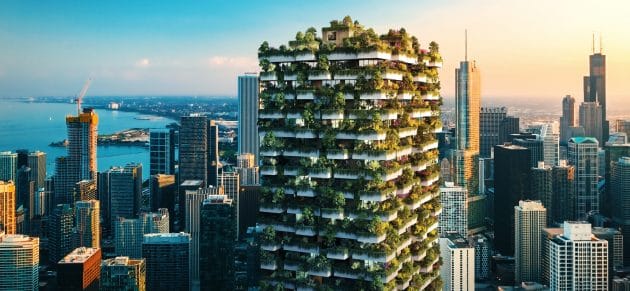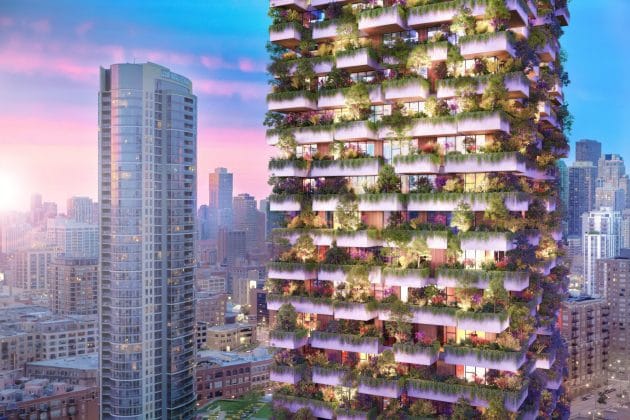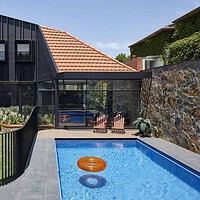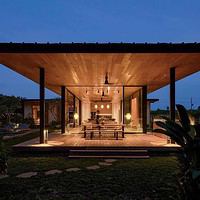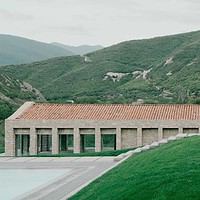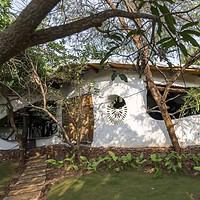Though green buildings aren’t new in the world of architecture, they’ve taken on a renewed sense of importance as we work to create sustainable cities and reduce our impact on both human health and the environment. Between 2005 and 2014, green construction spending in the US alone increased 12 fold, driven largely by tax credits and desirable operational cost savings.
In this piece, we’ll look at what green building is, the features that make a building ‘green,’ and some of the key benefits that green buildings deliver.
Green Building Architectural Rendering by: RealSpace 3D
Understanding green building
The World Green Building Council broadly defines a green building as one that, “in its design, construction, or operation, reduces or eliminates negative impacts and can create positive impacts on our climate and natural environment.” Green buildings are intended to both preserve natural resources and improve quality of life. The most widely used certification for green buildings is LEED — Leadership in Energy and Environmental Design.
What makes a building green varies widely and may include, but is not limited to, the following:
- Efficient use of resources, including energy and water;
- Use of renewable energy (e.g., solar energy);
- Inclusion of waste reduction, re-use, and recycling measures;
- Good indoor environmental air quality;
- Use of non-toxic, ethical, and sustainable materials;
- Consideration of the environment in design, construction, and operation;
- Consideration of the quality of life of occupants in design, construction, and operation; and/or
- A design that enables adaptation to a changing environment.
It’s critical to note that there isn’t a single ‘right’ approach to green building. Green buildings can and should vary depending on context, with importance being placed on factors such as climate, culture, building type, and regional priorities (environmental, social, and economic).
Regardless of the location, green buildings offer a wealth of benefits ranging from energy savings to improved health and wellness.
Architectural rendering provided by: RealSpace 3D
The economic benefits of green building
For many organizations and cities, design and building decisions often come down to the bottom line. But green building and economic viability aren’t mutually exclusive. According to a 2016 Dodge Data & Analytics report, building owners report that green buildings — both new and renovated — command a 7 percent increase in asset value over traditional buildings, while research published by National Geographic shows a 20 percent drop in maintenance costs and 17 percent higher occupancy rates in LEED-certified buildings versus traditional construction. Beyond this, there are two key economic benefits to green buildings: energy savings and boosts in human performance.
Energy savings
While these savings aren’t recognized immediately, green buildings do show significantly reduced energy demand over the long term.
The Environmental Protection Agency (EPA) notes green roofs and living walls as two mitigation strategies to the urban heat island effect, which increases peak energy demand, air conditioning costs, air and water pollution, greenhouse gas emissions, and heat-related illness and mortality in cities. While outdoor living walls act as a barrier and reduce the strain on HVAC systems in the buildings they adorn, indoor living walls act as insulation and regulate the environment inside a building, protecting it from temperature swings. In a study published by the journal Indoor and Built Environment, researchers found that living walls cooled a space by four to six degrees Celsius, a shift that significantly reduces the burden on air conditioning systems — particularly during periods of extreme heat.
Overall, studies show that green roofs result in up to 75 percent air conditioning savings and 25 percent winter heat savings, as well as 11 percent natural gas savings and 2 percent electricity savings.
Employee health and performance
It should come as no surprise that employee health is directly correlated to a company’s bottom line. OSHA estimates that sick leave and poor work performance costs employers about $15 billion annually, while the American Institute of Stress puts the annual toll on U.S. businesses at $300 billion.
Many green buildings create living walls to introduce greenery and use non-toxic building materials, both of which contribute to improving air quality indoors, where we spend about 90 percent of our time. Indoor air quality is an important, but often overlooked health and safety issue that can be incredibly costly to employers. By improving ventilation, reducing concentrations of CO2 and pollutants, and choosing materials that don’t use toxic chemicals, businesses can benefit from reduced sick leave and improvements in performance of up to 8 percent.
Hospital research specifically links the presence of plants to lower health care costs, finding that patients recovering in rooms with plants experienced significantly shorter hospitalizations, a reduced need for analgesics, and lower anxiety. This group also reported being more satisfied, relaxed, comfortable, and calm — all feelings that bolster wellness in the workplace.
Productivity, of course, is a key factor contributing to a company’s bottom line, and a study out of Washington State University examined the impact of greenery on worker productivity. Researchers found that participant productivity increased a whopping 12 percent when there were plants in the room. Another conducted by Texas A&M University placed participants in office environments with or without plant life and asked them to perform a variety of creative problem-solving tasks. Those in the plant-adorned spaces demonstrated greater innovation and ideation, with men generating an average of 15 percent more ideas overall and women offering more creative solutions than their counterparts without plants.
Linking green building and wellness
From an overall wellness perspective, the case for green building is compelling. Studies show that a 20-minute walk in nature can reduce all inflammatory markers in our bodies. In the same vein, being surrounded by plants — such as those on living walls or rooftop gardens in green buildings — increases our sense of well being and reduces stress. Organizational psychologist Cary Cooper found that employees with access to natural elements in their workspaces reported increased perceptions of well being by up to 15 percent.
The green building movement isn’t just about reducing waste and opting for more sustainable solutions, but about taking a holistic approach that considers how buildings affect the people who use them. As the report Human Spaces: The Global Impact of Biophilic Design in the Workplace notes, “The relationship between individuals and their environment can be a crucial determinant of how they feel, perform, and interact with others. So, designing spaces that inspire, energize, and support the people who use them is a global imperative.”
With ‘wellness’ continuing to be a buzzword in businesses around the world, the question isn’t so much whether we can afford to invest in green buildings, but whether we can afford not to.
The final word
Green building may cost more up front, but the long-term returns certainly outweigh the initial investment. Whether it’s the use of eco-friendly materials, re-use and recycling programs, renewable energy inclusions, or wellness features like living walls, there is plenty of evidence backing substantial economic, human, and environmental benefits of green building. And as the focus on sustainability in cities continues to grow, there’s little doubt that investment in green buildings will, too.

